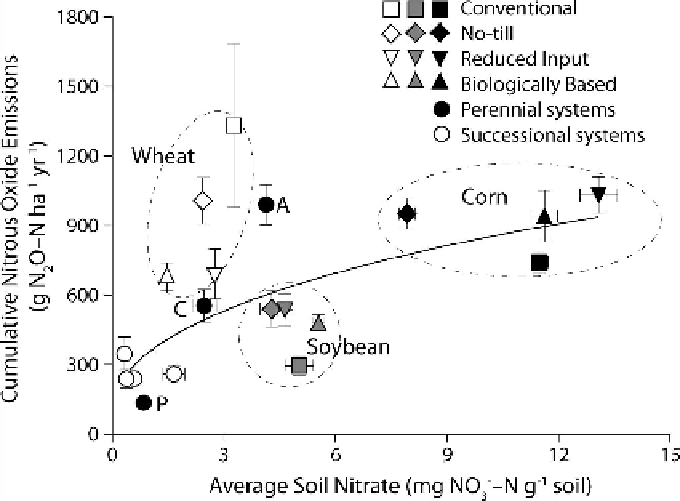Agriculture Reference
In-Depth Information
Figure 12.3
. Relationship between soil nitrous oxide (N
2
O) emissions and KCl-extractable
nitrate (NO
3
−
) in near-surface soils, fit with a power regression (y = 358.9 × (1 − e
(0.37)
),
R
2
= 0.58, p < 0.001; the wheat portions of Conventional and No-till systems are not included in
the regression). Annual systems are circled by crop; perennial systems are labeled as A = Alfalfa,
P = Poplar, and C = Coniferous Forest.
Nitrous oxide is also emitted from aquatic systems that drain agricultural water-
sheds. Considerable NO
3
−
is lost from intensively fertilized fields (Syswerda et al.
2012, Hamilton 2015, Chapter 11 in this volume), and based on watershed mass
balances, most of this NO
3
−
appears to be denitrified to N
2
O and N
2
. A recent cross-
site study of stream N cycling that includes the broader watershed around KBS
(Beaulieu et al. 2008, 2011) suggests that streams and rivers play a particularly
important role in N transformations, and may be responsible for a surprising pro-
portion of global anthropogenic N
2
O emissions.
Methane is consumed by—rather than emitted from—most field crop sys-
tems other than flooded rice. In most well-aerated soils, more CH
4
is oxidized
to CO
2
by methanotrophic bacteria than is produced by methanogenic bacte-
ria. This means that soil methanotrophs also consume atmospheric CH
4
, help-
ing to attenuate atmospheric concentrations that would otherwise build at even
higher rates than are occurring today. Methane oxidation by soil methanotrophs
is estimated to consume around 30 Tg yr
−1
. Although this is only ~5% of the
total global CH
4
flux (Forster et al. 2007), it is close to the rate at which CH
4
is accumulating in the atmosphere (37 Tg yr
−1
), suggesting that were consump-
tion reduced—or intensified—atmospheric concentrations might be likewise
affected.

